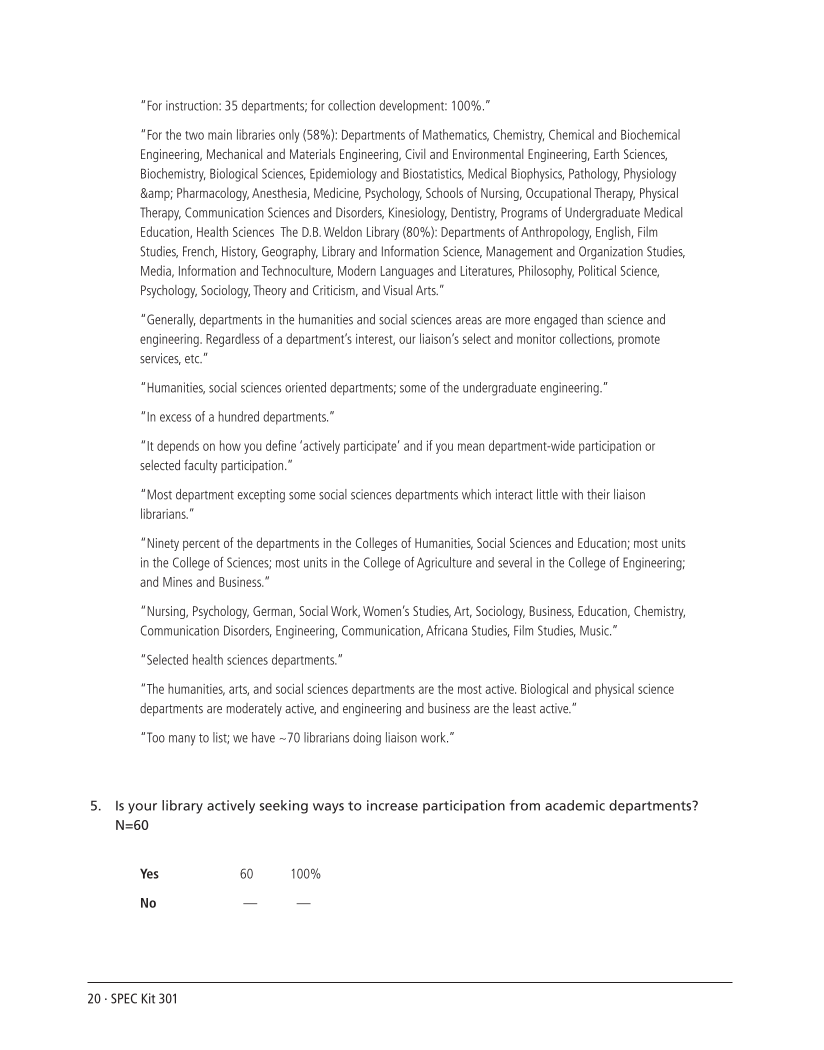20 · SPEC Kit 301
“For instruction: 35 departments for collection development: 100%.”
“For the two main libraries only (58%): Departments of Mathematics, Chemistry, Chemical and Biochemical
Engineering, Mechanical and Materials Engineering, Civil and Environmental Engineering, Earth Sciences,
Biochemistry, Biological Sciences, Epidemiology and Biostatistics, Medical Biophysics, Pathology, Physiology
& Pharmacology, Anesthesia, Medicine, Psychology, Schools of Nursing, Occupational Therapy, Physical
Therapy, Communication Sciences and Disorders, Kinesiology, Dentistry, Programs of Undergraduate Medical
Education, Health Sciences The D.B. Weldon Library (80%): Departments of Anthropology, English, Film
Studies, French, History, Geography, Library and Information Science, Management and Organization Studies,
Media, Information and Technoculture, Modern Languages and Literatures, Philosophy, Political Science,
Psychology, Sociology, Theory and Criticism, and Visual Arts.”
“Generally, departments in the humanities and social sciences areas are more engaged than science and
engineering. Regardless of a department’s interest, our liaison’s select and monitor collections, promote
services, etc.”
“Humanities, social sciences oriented departments some of the undergraduate engineering.”
“In excess of a hundred departments.”
“It depends on how you define ‘actively participate’ and if you mean department-wide participation or
selected faculty participation.”
“Most department excepting some social sciences departments which interact little with their liaison
librarians.”
“Ninety percent of the departments in the Colleges of Humanities, Social Sciences and Education most units
in the College of Sciences most units in the College of Agriculture and several in the College of Engineering
and Mines and Business.”
“Nursing, Psychology, German, Social Work, Women’s Studies, Art, Sociology, Business, Education, Chemistry,
Communication Disorders, Engineering, Communication, Africana Studies, Film Studies, Music.”
“Selected health sciences departments.”
“The humanities, arts, and social sciences departments are the most active. Biological and physical science
departments are moderately active, and engineering and business are the least active.”
“Too many to list we have ~70 librarians doing liaison work.”
5. Is your library actively seeking ways to increase participation from academic departments?
N=60
Yes 60 100%
No — —
“For instruction: 35 departments for collection development: 100%.”
“For the two main libraries only (58%): Departments of Mathematics, Chemistry, Chemical and Biochemical
Engineering, Mechanical and Materials Engineering, Civil and Environmental Engineering, Earth Sciences,
Biochemistry, Biological Sciences, Epidemiology and Biostatistics, Medical Biophysics, Pathology, Physiology
& Pharmacology, Anesthesia, Medicine, Psychology, Schools of Nursing, Occupational Therapy, Physical
Therapy, Communication Sciences and Disorders, Kinesiology, Dentistry, Programs of Undergraduate Medical
Education, Health Sciences The D.B. Weldon Library (80%): Departments of Anthropology, English, Film
Studies, French, History, Geography, Library and Information Science, Management and Organization Studies,
Media, Information and Technoculture, Modern Languages and Literatures, Philosophy, Political Science,
Psychology, Sociology, Theory and Criticism, and Visual Arts.”
“Generally, departments in the humanities and social sciences areas are more engaged than science and
engineering. Regardless of a department’s interest, our liaison’s select and monitor collections, promote
services, etc.”
“Humanities, social sciences oriented departments some of the undergraduate engineering.”
“In excess of a hundred departments.”
“It depends on how you define ‘actively participate’ and if you mean department-wide participation or
selected faculty participation.”
“Most department excepting some social sciences departments which interact little with their liaison
librarians.”
“Ninety percent of the departments in the Colleges of Humanities, Social Sciences and Education most units
in the College of Sciences most units in the College of Agriculture and several in the College of Engineering
and Mines and Business.”
“Nursing, Psychology, German, Social Work, Women’s Studies, Art, Sociology, Business, Education, Chemistry,
Communication Disorders, Engineering, Communication, Africana Studies, Film Studies, Music.”
“Selected health sciences departments.”
“The humanities, arts, and social sciences departments are the most active. Biological and physical science
departments are moderately active, and engineering and business are the least active.”
“Too many to list we have ~70 librarians doing liaison work.”
5. Is your library actively seeking ways to increase participation from academic departments?
N=60
Yes 60 100%
No — —












































































































































































